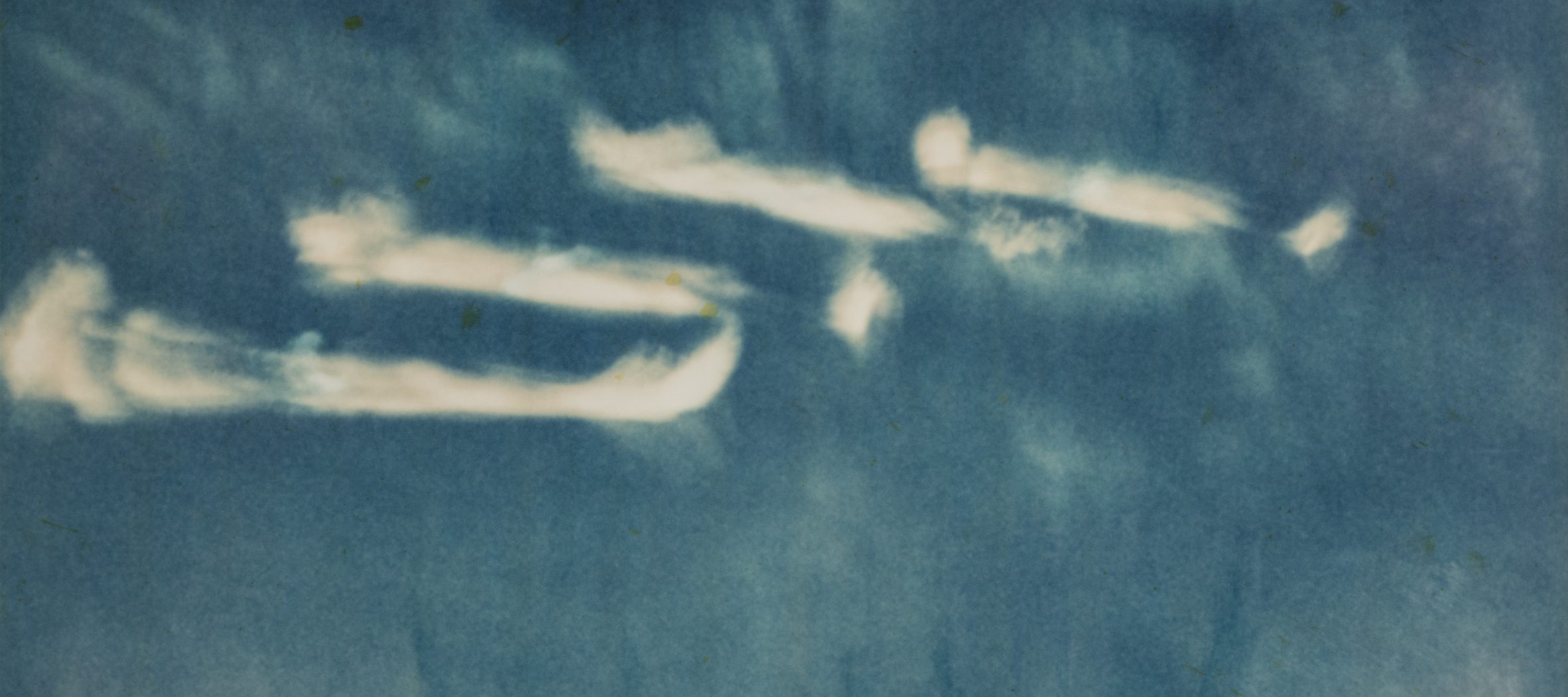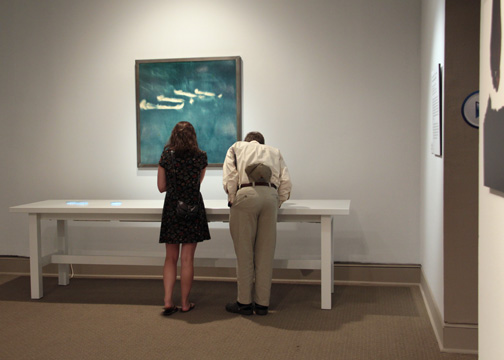Upon entering the exhibition Total Art: Contemporary Video, your attention may be drawn to the large blue artwork on the opposite wall. From a distance, it is challenging to determine the print’s context and subject. As you approach it more closely, however, you realize the work’s content is just as ambiguous in close proximity. The majority of the image is a nondescript, turquoise-tinted background. The upper portion contains four off-white, thick, irregular, horizontal lines that are staggered on top of one another, barely alluding to a sense of depth.
The work in question is One-Person Game Against Nature, No. 35 (1993) by Michal Rovner (b. 1957, Tel Aviv, Israel)—a chromogenic print reproduction of a frozen video image. The work is installed just above an elongated, sleek, white table with glass petri dishes erratically arranged along its length. This is another work by Rovner, Data Zone, Cultures Table #3 (2003), which incorporates moving video segments via hidden monitors under the table. As you peer into the petri dishes, you are greeted by miniscule objects that appear to be alive. They evoke bacteria or insects but as you look closely at all the dishes, something astonishing happens—the objects that are swarming or repeating their movements become recognizable as atomized human forms. Rovner recorded the movement of a group of people from above and transformed them through a heavy editing process that obscures any previously detectable natural arrangement.

Rovner’s digitized trompe l’oeil doesn’t stop there. A closer examination of One-Person Game reveals the same concept—given a second look, the lines and abstracted forms are human silhouettes. For this work, Rovner video-recorded four young men floating in the Dead Sea and then enlarged and amplified a still shot from the recording to create the grainy, ambiguous, and enigmatic image that scarcely suggests human forms.
A more pessimistic blogger might suggest that in reducing figures to this microscopic and unrecognizable level, Rovner diminishes notions of individual human identity. However, Rovner leaves traces of humanity in both of these works. In removing key associative details, she asks viewers to look again and look more deeply. Michal Rovner operates in the realm of human experience and her concepts function as a wondrous marriage between magic, mad science, and art. Rovner’s removal of detail allows viewers to open their minds. As scholar Sylvia Wolf explains, in “. . . seeing less, we imagine more.”¹
Rovner sees her video and photographic works as operating outside accepted reality. Commenting on her own inspirations for her projects, she notes:
I am looking for a point of departure from concreteness. But I don’t want to totally lose the presence of something, or even the meaning of what it was, or used to be, or could have been . . . And maybe it has potential—energy, information, visual information – to make a very strong statement about a specific reality, which an exact recording of that reality wouldn’t have. ²
Visit NMWA on Wednesday, July 23 at noon for a weekly staff-led gallery talk and hear from Curatorial Assistant Stephanie Midon as she discusses Rovner’s Data Zone, Cultures Table #3. Because doesn’t everyone deserve a little magic on their lunch break? We think so.
Notes:
1. Sylvia Wolf, “The Space Between,” in Michal Rovner: The Space Between, Sylvia Wolf, ed., (Chicago: The Art Institute of Chicago, 2001), 68.
2. Michal Rovner as quoted in “Michal Rovner and Leon Golub in Conversation, 20 March and 1 April 2001,” in Michal Rovner: The Space Between, Sylvia Wolf.

